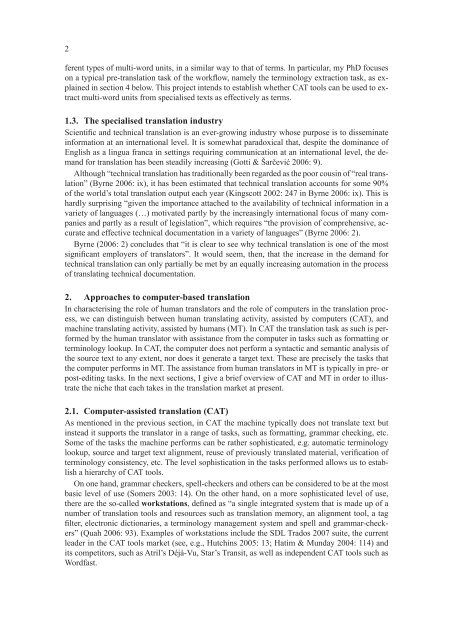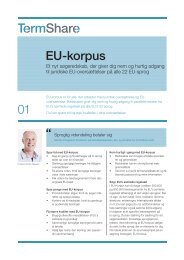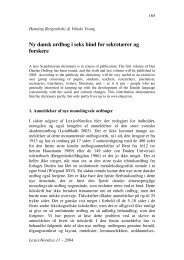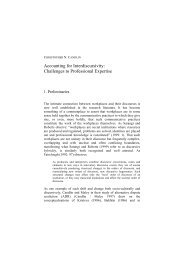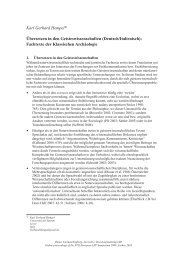The Workflow of Computer-Assisted Translation Tools in
The Workflow of Computer-Assisted Translation Tools in
The Workflow of Computer-Assisted Translation Tools in
You also want an ePaper? Increase the reach of your titles
YUMPU automatically turns print PDFs into web optimized ePapers that Google loves.
2<br />
ferent types <strong>of</strong> multi-word units, <strong>in</strong> a similar way to that <strong>of</strong> terms. In particular, my PhD focuses<br />
on a typical pre-translation task <strong>of</strong> the workfl ow, namely the term<strong>in</strong>ology extraction task, as expla<strong>in</strong>ed<br />
<strong>in</strong> section 4 below. This project <strong>in</strong>tends to establish whether CAT tools can be used to extract<br />
multi-word units from specialised texts as effectively as terms.<br />
1.3. <strong>The</strong> specialised translation <strong>in</strong>dustry<br />
Scientifi c and technical translation is an ever-grow<strong>in</strong>g <strong>in</strong>dustry whose purpose is to dissem<strong>in</strong>ate<br />
<strong>in</strong>formation at an <strong>in</strong>ternational level. It is somewhat paradoxical that, despite the dom<strong>in</strong>ance <strong>of</strong><br />
English as a l<strong>in</strong>gua franca <strong>in</strong> sett<strong>in</strong>gs requir<strong>in</strong>g communication at an <strong>in</strong>ternational level, the demand<br />
for translation has been steadily <strong>in</strong>creas<strong>in</strong>g (Gotti & Šarčević 2006: 9).<br />
Although “technical translation has traditionally been regarded as the poor cous<strong>in</strong> <strong>of</strong> “real translation”<br />
(Byrne 2006: ix), it has been estimated that technical translation accounts for some 90%<br />
<strong>of</strong> the world’s total translation output each year (K<strong>in</strong>gscott 2002: 247 <strong>in</strong> Byrne 2006: ix). This is<br />
hardly surpris<strong>in</strong>g “given the importance attached to the availability <strong>of</strong> technical <strong>in</strong>formation <strong>in</strong> a<br />
variety <strong>of</strong> languages (…) motivated partly by the <strong>in</strong>creas<strong>in</strong>gly <strong>in</strong>ternational focus <strong>of</strong> many companies<br />
and partly as a result <strong>of</strong> legislation”, which requires “the provision <strong>of</strong> comprehensive, accurate<br />
and effective technical documentation <strong>in</strong> a variety <strong>of</strong> languages” (Byrne 2006: 2).<br />
Byrne (2006: 2) concludes that “it is clear to see why technical translation is one <strong>of</strong> the most<br />
signifi cant employers <strong>of</strong> translators”. It would seem, then, that the <strong>in</strong>crease <strong>in</strong> the demand for<br />
technical translation can only partially be met by an equally <strong>in</strong>creas<strong>in</strong>g automation <strong>in</strong> the process<br />
<strong>of</strong> translat<strong>in</strong>g technical documentation.<br />
2. Approaches to computer-based translation<br />
In characteris<strong>in</strong>g the role <strong>of</strong> human translators and the role <strong>of</strong> computers <strong>in</strong> the translation process,<br />
we can dist<strong>in</strong>guish between human translat<strong>in</strong>g activity, assisted by computers (CAT), and<br />
mach<strong>in</strong>e translat<strong>in</strong>g activity, assisted by humans (MT). In CAT the translation task as such is performed<br />
by the human translator with assistance from the computer <strong>in</strong> tasks such as formatt<strong>in</strong>g or<br />
term<strong>in</strong>ology lookup. In CAT, the computer does not perform a syntactic and semantic analysis <strong>of</strong><br />
the source text to any extent, nor does it generate a target text. <strong>The</strong>se are precisely the tasks that<br />
the computer performs <strong>in</strong> MT. <strong>The</strong> assistance from human translators <strong>in</strong> MT is typically <strong>in</strong> pre- or<br />
post-edit<strong>in</strong>g tasks. In the next sections, I give a brief overview <strong>of</strong> CAT and MT <strong>in</strong> order to illustrate<br />
the niche that each takes <strong>in</strong> the translation market at present.<br />
2.1. <strong>Computer</strong>-assisted translation (CAT)<br />
As mentioned <strong>in</strong> the previous section, <strong>in</strong> CAT the mach<strong>in</strong>e typically does not translate text but<br />
<strong>in</strong>stead it supports the translator <strong>in</strong> a range <strong>of</strong> tasks, such as formatt<strong>in</strong>g, grammar check<strong>in</strong>g, etc.<br />
Some <strong>of</strong> the tasks the mach<strong>in</strong>e performs can be rather sophisticated, e.g. automatic term<strong>in</strong>ology<br />
lookup, source and target text alignment, reuse <strong>of</strong> previously translated material, verifi cation <strong>of</strong><br />
term<strong>in</strong>ology consistency, etc. <strong>The</strong> level sophistication <strong>in</strong> the tasks performed allows us to establish<br />
a hierarchy <strong>of</strong> CAT tools.<br />
On one hand, grammar checkers, spell-checkers and others can be considered to be at the most<br />
basic level <strong>of</strong> use (Somers 2003: 14). On the other hand, on a more sophisticated level <strong>of</strong> use,<br />
there are the so-called workstations, defi ned as “a s<strong>in</strong>gle <strong>in</strong>tegrated system that is made up <strong>of</strong> a<br />
number <strong>of</strong> translation tools and resources such as translation memory, an alignment tool, a tag<br />
fi lter, electronic dictionaries, a term<strong>in</strong>ology management system and spell and grammar-checkers”<br />
(Quah 2006: 93). Examples <strong>of</strong> workstations <strong>in</strong>clude the SDL Trados 2007 suite, the current<br />
leader <strong>in</strong> the CAT tools market (see, e.g., Hutch<strong>in</strong>s 2005: 13; Hatim & Munday 2004: 114) and<br />
its competitors, such as Atril’s Déjà-Vu, Star’s Transit, as well as <strong>in</strong>dependent CAT tools such as<br />
Wordfast.


